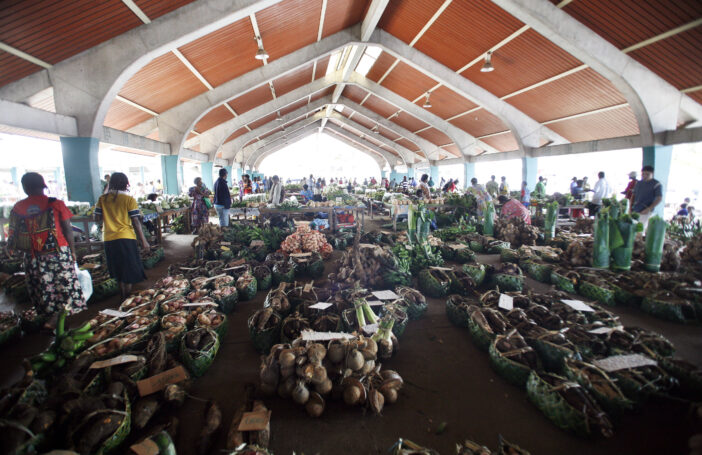The Papua New Guinea (PNG) National Statistical Office (NSO) recently released the Demographic and Health Survey (DHS) 2016-2018 key indicators report. The survey on which this report is based was implemented by the NSO, the National Department of Health and other PNG agencies with support from Australia’s aid program, the DHS program, UNFPA and UNICEF. It was the third DHS conducted in PNG, the first being conducted in 1996 and the second in 2006. (For more on the DHS in general, see my companion blog.)
There are positive aspects to this particular PNG report. First, the survey on which it is based is relatively comprehensive, collecting information on, “fertility, awareness and use of family planning methods, breastfeeding practices, nutritional status of children, maternal and child health, adult and childhood mortality, women’s empowerment, domestic violence, malaria, awareness and behaviour regarding HIV/AIDS and other sexually transmitted infections, and other health-related issues.” The DHS also collected information on household agricultural activities and household food security. Second, the vast majority of the tables in the report disaggregate the survey data by age brackets, sex, residence (rural vs urban), region (for example, highland provinces vs island provinces), education levels; and wealth quintiles, thereby providing some insight into equity of access and outcomes in the health sector. Third, the use of a standardised methodology provides the evidence base for PNG officials to themselves track progress over time (though annoyingly, the latest report does not always compare findings with earlier results in a number of cases) and compare trends with other countries.
The quality of statistical data is frequently a problematic issue in PNG. The DHS report gives details of the methodology used. It notes that 53 teams, involving over 370 personnel, were involved over the period October 2016-December 2018. 16,000 representative households, including over 15,000 women and over 7,000 men, were surveyed, 87% of whom were living in rural areas in PNG. The report acknowledges, however, delays and challenges. These included “inaccessibility due to the geography of the country and severe weather patterns, refusal by respondents to participate in the survey, need for security due to law and order situations and outstanding payments owed to service providers, absence of reliable communication services, and late disbursement of funds to support teams in the field. As a result, fieldwork could be completed only for 767 clusters of the 800 initially selected.” Nevertheless, the report concludes that “the 2016-18 PNG DHS is nationally representative and covers the entire population residing in private dwelling units in the country.”
The report’s preliminary survey results include some positive findings. For example, the under five year old mortality rate is estimated to have dropped in PNG from 92.8 deaths per 1,000 live births in 1996 to 49 per 1,000 in 2016. Within that reduction the neonatal mortality rate has fallen from 31.6 deaths/1,000 to 20/1,000; the postnatal mortality rate dropped from 37.7/1,000 to 13/1,000; the infant mortality dropped from 69.3/1,000 to 33/1,000; and the child mortality fell from 25/1,000 to 16/1,000.
There are any number of other important findings in the report:
- The national level Total Fertility Rate is still relatively high at 4.2 average number of children born per woman, down slightly from 4.4 in 2006 and 4.8 in 1996. Teenage childbearing has declined from 13.9% of teenagers in 1996 to 12.5% in 2016-18.
- Three quarters of rural women (and 89% of urban women) surveyed received antenatal care from a skilled provider with a live birth in the 5 years before the survey. However less than half (47%) of rural women and less than two-thirds (63%) of urban women received the recommended minimum of 4 ANC visits. In short, many women are reached by the health system initially, but then discontinue or drop out.
- Equity of access remains an issue. For example, while 85% of urban women delivered a baby in a health facility, usually with a skilled provider, only 51% of women in rural areas did so.
- Just under half (49%) of currently married women report their demand for family planning is met by modern methods: just over a quarter (26%) report an unmet need.
- Less than 20% of children aged 6-23 months are fed the minimum acceptable diet for their age group. This is a critical issue for a child’s development given the findings of the 1,000 days campaign.
- Only 35% of children received all basic vaccinations, but 24% have none. Importantly, while around 60% or 70% of children in PNG receive their first polio, measles and rubella, and DPT, Hep B and Hib vaccinations, the rates fall to around 40% for the second and third follow up vaccinations. Only 20.7% of children in the lowest quintile surveyed had received the third polio vaccine, compared to 62.3% in the highest quintile.
- 59% of women aged 15-49 years surveyed had experienced physical or sexual violence in their lifetime.
A DHS is not an end in itself but a means to an end – better informed policies and programs. Data quality is always an issue in PNG, and so there can be room for legitimate questions about some of the progress reported. Even with that caveat, many of the findings still do raise fundamental questions about public health and the extent and equity of service delivery. It is important therefore that the PNG DHS gets profile, attention, and “ownership” from PNG policy makers. It will be a major lost opportunity if this DHS report sits on a shelf with other unread reports. Or if there are long delays in publishing the final report (the 2006 PNG DHS was not published until 3 years later, in 2009). Critically assessing and then actively using the data and insights of the latest DHS are especially important given that PNG authorities understandably argue for more control over their own policy formulation. PNG media and civil society have a vital role to play to ensure that the DHS findings get profile and traction among policy makers and the public more broadly.
Read the author’s companion blog on the DHS here.





Hello Ian.
I was one of the interviewers in the DHS 2016. I definitely appreciated your comments and I considered your thoughts a fair justification to policy making in PNG. PNG as i know has some very good policies however most of it gather dust on a shelf. Considering that, i believe that primary information like this is the backbone to a relevant project proposal and if so better project monitoring and evaluation. The stakeholders in doing this survey must be applauded especially AusAID for funding. I see a need for relevance as a main factor and DHS is one. It was done by NSO and so i do think it’s not bias as it does not come from NDOH. The government of the day has to decide which areas of concern to address. Most projects planning and design stem from logical framework approach in that case DHS is the great way to access that information.
Regards
Wellington Panta
The full text of the PNG DHS, rather than just the PNG DHS Key Indicators summary, was released on 25 November. The full data set can be downloaded after registering with the DHS program here.